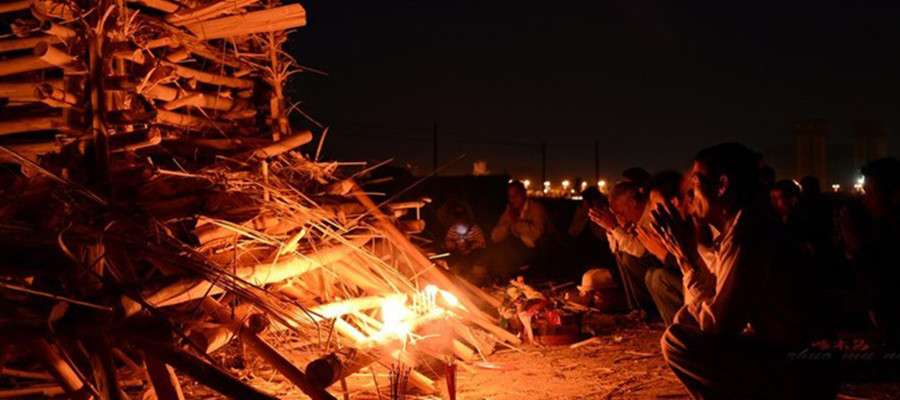Shaobaichai (Firewood) Festival of Deang Ethnic Minority
Overiew of The Festival
- Chinese Name: 德昂族烧白柴节
- English Name: Shaobaichai (Firewood) Festival of Deang Ethnic Minority
Burning White Firewood is the Deang people’s festival for honoring the Buddha, celebrated on December 14th of each year according to the Gregorian calendar. On this evening, a 5-meter-high white firewood pagoda is erected in the square outside the village and set on fire. The De’ang people believe that as the cold season approaches, the Buddha may feel chilly, so they need to burn white firewood to provide warmth for the Buddha, driving away the cold and symbolizing the addition of warmth.

Local Activities during the Shaobaichai Festival
- Firewood Collection and Preparation: Leading up to the festival, families gather firewood from the forest, which is an essential part of the celebrations. This practice not only prepares them for the festival but also strengthens community bonds as people work together.
- Ritual Offerings: On the first day of the festival, families prepare offerings that include food, fruits, and flowers, which are presented to ancestors and local deities. This is a time for reflection and gratitude for the bounties of nature, and the offerings symbolize respect and acknowledgment of familial and spiritual connections.
- Bonfire Lighting: A central feature of the Shaobaichai Festival is lighting a large bonfire. This bonfire serves as a communal focal point for the festivities and symbolizes warmth, joy, and the dispelling of evil spirits. Community members gather around the fire, celebrating together.
- Traditional Music and Dance: Music and dance are integral parts of the festival. Traditional instruments such as the “huzheng” (a type of string instrument) are played, and people perform folk dances that tell stories of their culture, history, and daily life. These performances often involve colorful costumes and expressive movements, creating a lively and festive atmosphere.
- Food Preparation and Sharing: Families prepare a variety of traditional dishes to share during the festival. This often includes locally sourced ingredients and can feature rice, meats, vegetables, and traditional snacks. Meals are communal, emphasizing the festival’s focus on community and sharing.
- Games and Competitions: Various traditional games and competitions take place, including sports, races, and skill-based challenges. These activities foster camaraderie and festivity among the participants and are enjoyed by both children and adults.
- Cultural Exhibitions: Festivals often include exhibitions showcasing Deang handicrafts, textiles, and artistic expressions. This provides an opportunity for the community to celebrate its artisans and preserve its cultural heritage.
- Community Feasting: The festival culminates in a large communal feast where families and visitors come together to share the dishes prepared. This emphasizes the spirit of unity and appreciation within the community.
- Storytelling and Folklore: Elders often gather to share stories, folklore, and traditional wisdom with younger generations, fostering an appreciation of their cultural heritage and history.

 7 Days GolfingTour
7 Days GolfingTour
 8 Days Group Tour
8 Days Group Tour
 8 Days Yunnan Tour
8 Days Yunnan Tour
 7 Days Shangri La Hiking
7 Days Shangri La Hiking
 11 Days Yunnan Tour
11 Days Yunnan Tour
 6 Days Yuanyang Terraces
6 Days Yuanyang Terraces
 11 Days Yunnan Tour
11 Days Yunnan Tour
 8 Days South Yunnan
8 Days South Yunnan
 7 Days Tea Tour
7 Days Tea Tour
 8 Days Muslim Tour
8 Days Muslim Tour
 12 Days Self-Driving
12 Days Self-Driving
 4 Days Haba Climbing
4 Days Haba Climbing
 Tiger Leaping Gorge
Tiger Leaping Gorge
 Stone Forest
Stone Forest
 Yunnan-Tibet
Yunnan-Tibet
 Hani Rice Terraces
Hani Rice Terraces
 Kunming
Kunming
 Lijiang
Lijiang
 Shangri-la
Shangri-la
 Dali
Dali
 XishuangBanna
XishuangBanna
 Honghe
Honghe
 Kunming
Kunming
 Lijiang
Lijiang
 Shangri-la
Shangri-la
 Yuanyang Rice Terraces
Yuanyang Rice Terraces
 Nujiang
Nujiang
 XishuangBanna
XishuangBanna
 Spring City Golf
Spring City Golf
 Snow Mountain Golf
Snow Mountain Golf
 Stone Mountain Golf
Stone Mountain Golf














